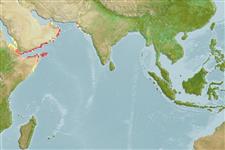Klassifizierung / Names
Namen | Synonyme | Catalog of Fishes(Gattung, Arten) | ITIS | CoL | WoRMS | Cloffa
Environment: milieu / climate zone / depth range / distribution range
Ökologie
seewasser riff-verbunden. Tropical
Western Indian Ocean: Red Sea, Oman and Gulf of Aden.
Size / Gewicht / Alter
Maturity: Lm ? range ? - ? cm
Max length : 15.4 cm Männchen/unbestimmt; (Ref. 124862)
Kurzbeschreibung
Bestimmungsschlüssel | Morphologie | Morphometrie
This species is similar to Chaetodon vagabundus except for the following: that the black band running up the rear of the body merges with the black dorsal fin margin and eye band, thus forming a horseshoe mark; the black tail fin bands are replaced by reddish brown bands; and the soft dorsal and anal fins of adults are more pointed (Ref. 58304).
Life cycle and mating behavior
Maturities | Fortpflanzung | Spawnings | Egg(s) | Fecundities | Larven
Heemstra, P.C. and E. Heemstra, 2004. Coastal fishes of Southern Africa. National Inquiry Service Centre (NISC) and South African Institute for Aquatic Biodiversity (SAIAB), Grahamstown. 488 p. (Ref. 58304)
IUCN Rote Liste Status (Ref. 130435)
Bedrohung für Menschen
Harmless
Nutzung durch Menschen
Tools
Zusatzinformationen
Download XML
Internet Quellen
Estimates based on models
Preferred temperature (Ref.
123201): 25.5 - 28.3, mean 26.8 °C (based on 60 cells).
Phylogenetic diversity index (Ref.
82804): PD
50 = 0.5000 [Uniqueness, from 0.5 = low to 2.0 = high].
Bayesian length-weight: a=0.02291 (0.01133 - 0.04632), b=3.00 (2.83 - 3.17), in cm total length, based on LWR estimates for this Genus-body shape (Ref.
93245).
Trophic level (Ref.
69278): 3.3 ±0.6 se; based on size and trophs of closest relatives
Generation time: 1.3 ( na - na) years. Estimated as median ln(3)/K based on 1
growth studies.
Widerstandsfähigkeit (Ref.
120179): hoch, Verdopplung der Population dauert weniger als 15 Monate. (Preliminary K or Fecundity.).
Fishing Vulnerability (Ref.
59153): Low vulnerability (10 of 100).
